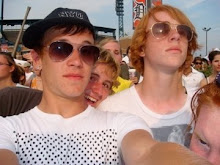 Tekkonkinkreet is absolutely beautiful, and I discovered it at the perfect time in my intersecting interests in manga and European comic influences. Created by Taiyō Matsumoto, Tekkonkinkreet is an amazing synthesis of different cultural storytelling methods. Ostensibly seinen, or manga aimed at adult males, Tekkonkinkreet’s story revolves on the predictably contrasting children Black and White as they cling to their decrepit neighborhood. From the first sequences, a sort of Of Mice and Men vibe settles in, in which you want to reach into the page and protect White before other influences can reach him. The tension felt palpable throughout the entire first portion, and I flipped the pages with mounting worry over what would become of the naïve, innocent half of the Cats.
Tekkonkinkreet is absolutely beautiful, and I discovered it at the perfect time in my intersecting interests in manga and European comic influences. Created by Taiyō Matsumoto, Tekkonkinkreet is an amazing synthesis of different cultural storytelling methods. Ostensibly seinen, or manga aimed at adult males, Tekkonkinkreet’s story revolves on the predictably contrasting children Black and White as they cling to their decrepit neighborhood. From the first sequences, a sort of Of Mice and Men vibe settles in, in which you want to reach into the page and protect White before other influences can reach him. The tension felt palpable throughout the entire first portion, and I flipped the pages with mounting worry over what would become of the naïve, innocent half of the Cats. Matsumoto-sensei’s storytelling is really the beauty of the book. Heavily influenced by European comic masters, Matsumoto-sensei populates his pages with bizarre and minute details, inviting the eye to heavily scrutinize every panel. While Americans have a limited knowledge of European comic creators, comparisons with one of the best are earned: Moebius is an admitted influence on Matsumoto-sensei’s work, and it’s evident in the pacing along with attention to detail. In some ways, Tekkonkinkreet feels oddly non-Japanese; the story revolves around two young boys fighting a large corporation, but nowhere does the storytelling devolves into splash pages of blurring limbs and loud exclamations. The action is frequently interspersed with quiet, subtle, and even confusing interactions, such as in the bathhouse sequence.
Matsumoto-sensei’s storytelling is really the beauty of the book. Heavily influenced by European comic masters, Matsumoto-sensei populates his pages with bizarre and minute details, inviting the eye to heavily scrutinize every panel. While Americans have a limited knowledge of European comic creators, comparisons with one of the best are earned: Moebius is an admitted influence on Matsumoto-sensei’s work, and it’s evident in the pacing along with attention to detail. In some ways, Tekkonkinkreet feels oddly non-Japanese; the story revolves around two young boys fighting a large corporation, but nowhere does the storytelling devolves into splash pages of blurring limbs and loud exclamations. The action is frequently interspersed with quiet, subtle, and even confusing interactions, such as in the bathhouse sequence.The animated adaptation seems to maintain much of this, but I still missed the shaky black-and-white of the comic, and the relative “silence” of much of the storytelling. I feel like I would have loved it if it was an original work, but as an adaptation, I can’t see how I would come to prefer it to the source material.
 The same sort of cross-cultural pollination can be seen in North American works like Brandon Graham’s King City and James Stokoe’s Orc Stain, which use some very interesting manga tactics, and the work of Geof Darrow, a direct student of the Moebius school. Too often, the influence of another continent’s comic style is limited to superficial details (“big eyes!”) but none of the substance. Tekkonkinkreet (and these titles) are examples of how to do that right. Tekkonkinkreet is also an excellent reminder that Japan produces manga that appeals to more than just 13-year-olds, even if that’s the only thing proven to sell in the States. For readers looking for more in the same vein, I’d recommend AX Volume 1: A Collection of Alternative Manga, and other works from Top Shelf, who aren’t afraid to ignore the market to which Viz and other US manga publishers cater.
The same sort of cross-cultural pollination can be seen in North American works like Brandon Graham’s King City and James Stokoe’s Orc Stain, which use some very interesting manga tactics, and the work of Geof Darrow, a direct student of the Moebius school. Too often, the influence of another continent’s comic style is limited to superficial details (“big eyes!”) but none of the substance. Tekkonkinkreet (and these titles) are examples of how to do that right. Tekkonkinkreet is also an excellent reminder that Japan produces manga that appeals to more than just 13-year-olds, even if that’s the only thing proven to sell in the States. For readers looking for more in the same vein, I’d recommend AX Volume 1: A Collection of Alternative Manga, and other works from Top Shelf, who aren’t afraid to ignore the market to which Viz and other US manga publishers cater.

No comments:
Post a Comment